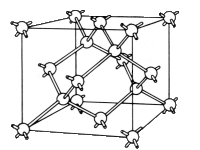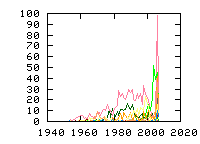« Previous
1
Next »
(20 hits, 1/1)
Showing
10, 25, 50, 100, 500, 1000, all papers per page.
Sort by:
last publication date,
older publication date,
last update date.
- 1. Phys. Rev. B 75, 195335 (2007) , “Computational and experimental imaging of Mn defects on GaAs (110) cross-sectional surfaces”, A. Stroppa, X. Duan, M. Peressi, D. Furlanetto, and S. ModestiWe present a combined experimental and computational study of the (110) cross-sectional surface of Mn δ-doped GaAs samples. We focus our study on three different selected Mn defect configurations not previously studied in detail, namely surface interstitial Mn, isolated and in pairs, and... (Read more)
- 2. Phys. Rev. B 75, 045210 (2007) , “Positron trapping kinetics in thermally generated vacancy donor complexes in highly As-doped silicon”, K. Kuitunen, K. Saarinen, and F. TuomistoWe have measured positron lifetime and Doppler broadening in highly As-doped silicon containing thermally generated V-As3 defect complexes (vacancy is surrounded by three arsenic atoms). We observe positron detrapping from the V-As3 defect complex and determine... (Read more)
- 3. Phys. Rev. B 75, 035211 (2007) , “Self- and foreign-atom diffusion in semiconductor isotope heterostructures. II. Experimental results for silicon”, H. Bracht, H. H. Silvestri, I. D. Sharp, and E. E. HallerWe report the diffusion of boron, arsenic, and phosphorus in silicon isotope multilayer structures at temperatures between 850 °C and 1100 °C. The diffusion of all dopants and self-atoms at a given temperature is modeled with the same setting of all native-point-defect-related parameters.... (Read more)
- 4. Phys. Rev. Lett. 98, 265502 (2007) , “Monovacancy and Interstitial Migration in Ion-Implanted Silicon”, P. G. Coleman and C. P. BurrowsThe migration of monovacancies (V0) and self-interstitials (I) has been observed in ion-implanted low-doped float-zone silicon by variable-energy positron annihilation spectroscopy. V0 and I were created by the in situ implantation of ~20 keV... (Read more)
- 5. Phys. Rev. B 74, 195202 (2006) , “Interstitial-mediated mechanisms of As and P diffusion in Si: Gradient-corrected density-functional calculations”, Scott A. Harrison, Thomas F. Edgar, and Gyeong S. HwangGradient-corrected density-functional calculations are used to determine the structure, stability, and diffusion of arsenic-interstitial and phosphorus-interstitial pairs in the positive, neutral, and negative charge states. For both cases, our calculations show that the neutral pair will be... (Read more)
- 6. Phys. Rev. B 74, 174206 (2006) , “Nuclear quadrupole resonance study of local bonding in glassy AsxSe1−x”, Eungho Ahn, G. A. Williams, and P. C. TaylorNuclear quadrupole resonance (NQR) experiments were performed on glassy AsxSe1−x to study the local structural order. The bonding in AsxSe1−x is governed by preferential bonding (chemical ordering) between arsenic... (Read more)
- 7. Phys. Rev. B 74, 035205 (2006) , “Mechanisms of arsenic clustering in silicon”, F. F. Komarov, O. I. Velichko, V. A. Dobrushkin, and A. M. MironovA model of arsenic clustering in silicon is proposed and analyzed. The main feature of the proposed model is the assumption that negatively charged arsenic complexes play a dominant role in the clustering process. To confirm this assumption, electron density and concentration of impurity atoms... (Read more)
- 8. Phys. Rev. B 74, 033304 (2006) , “5-7-5 line defects on As/Si(100): A general stress-relief mechanism for V/IV surfaces”, W. E. McMahon, Iskander G. Batyrev, T. Hannappel, J. M. Olson, and S. B. ZhangAn entire family of nano-scale trenches, ridges, and steps has been observed experimentally on AsH3-exposed Si(100). Some of these line structures have been observed previously, but their structures have remained a mystery. Theoretical modeling shows that they are all based upon the same... (Read more)
- 9. Phys. Rev. Lett. 97, 226401 (2006) , “Quasiparticle Corrections to the Electronic Properties of Anion Vacancies at GaAs(110) and InP(110)”, Magnus Hedström, Arno Schindlmayr, Günther Schwarz, and Matthias SchefflerWe propose a new method for calculating optical defect levels and thermodynamic charge-transition levels of point defects in semiconductors, which includes quasiparticle corrections to the Kohn-Sham eigenvalues of density-functional theory. Its applicability is demonstrated for anion vacancies at... (Read more)
- 10. Appl. Phys. Lett. 87, 231905 (2005) , “Structure, stability, and diffusion of arsenic-silicon interstitial pairs”, Scott A. Harrison, Thomas F. Edgar, and Gyeong S. HwangRecent experimental studies [A. Ural, P. B. Griffin, and J. D. Plummer, J. Appl. Phys. 85, 6440 (1999); R. Kim, T. Hirose, T. Shano, H. Tsuji, and K. Taniguchi, Jpn. J. Appl. Phys. 41, 227 (2002); S. Solmi, M. Ferri, M. Bersani, D. Giubertoni, and V. Soncini, J. Appl. Phys. 94,... (Read more)
- 11. Phys. Rev. Lett. 93, 255502 (2004) , “Formation of Thermal Vacancies in Highly As and P Doped Si”, V. Ranki and K. SaarinenUsing positron annihilation measurements we observed the formation of thermal vacancies in highly As and P doped Si. The vacancies start to form at temperatures as low as 650 K and are mainly undecorated at high temperatures. Upon cooling the vacancies form stable vacancy-impurity complexes such as... (Read more)
- 12. Physica B 308-310, 753-756 (2001) , “On the problem of the EL2 structure in semi-insulating GaAs: high-frequency ODEPR/ODENDOR measurements in W-band”, I. Tkach, K. Krambrock and J. -M. SpaethFor almost two decades the structure model of the EL2 defect in semi-insulating (SI) GaAs has been controversially discussed. Neither the isolated AsGa with Td symmetry, nor the AsGa–Asi pair model nor any other AsGa-related defect model could be unambiguously established. The reason was that... (Read more)
- 13. Phys. Rev. B 47, 6363-6380 (1993) , “Electron paramagnetic resonance of multistable interstitial-carbonsubstitutional-group-V-atom pairs in silicon”, X. D. Zhan, G. D. WatkinsA total of five new electron paramagnetic resonance (EPR) centers are observed in electron-irradiated P-, As-, and Sb-doped silicon. Three are identified as arising from the neutral charge state of the stable configuration and two of the four metastable configurations of an... (Read more)
- 14. Phys. Rev. B 46, 12335 (1992) , “Microscopic mechanism of atomic diffusion in Si under pressure ”, Osamu Sugino and Atsushi OshiyamaWe have performed the first-principles total-energy calculations on the atomic diffusion of group-V impurities in Si, and have revealed the pressure effect on the activation energy of the diffusion. For the vacancy mechanism, the activation energies for P, As, and Sb decrease with pressure. For the... (Read more)
- 15. Phys. Rev. B 7, 4547 (1973) , “Raman Scattering and Photoluminescence in Boron-Doped and Arsenic-Doped Silicon”, J. M. Cherlow, R. L. Aggarwal, and B. LaxThe deformation potentials and g values of the ground state of the boron acceptor in silicon have been determined from a study of the stress and Zeeman splitting of the electronic Raman scattering in this material. The stress splitting of the Raman line results from a twofold splitting of the... (Read more)
- 16. Phys. Rev. 174, 881 (1968) , “Defects in Irradiated Silicon: Electron Paramagnetic Resonance and Electron-Nuclear Double Resonance of the Arsenic- and Antimony-Vacancy Pairs”, Edward L. Elkin and G. D. WatkinsTwo EPR spectra are observed in irradiated silicon (designated Si-G23 and Si-G24) which are identified with the neutral charge states of a lattice vacancy adjacent to a substitutional arsenic or antimony atom, respectively. EPR and ENDOR studies reveal a high degree of similarity between these... (Read more)
- 17. Phys. Rev. 134, A265 (1964) , “Electron Spin Resonance Experiments on Shallow Donors in Germanium”, D. K. WilsonAt liquid helium temperatures, spin resonance of localized donor electrons has been observed in phorphorus-, arsenic-, and bismuth-doped germanium. The presence of hyperfine splitting confirms the singlet as the ground state for all three. The separation of the excited triplet states has been... (Read more)
- 18. Phys. Rev. 114, 1219 (1959) , “Electron Spin Resonance Experiments on Donors in Silicon. I. Electronic Structure of Donors by the Electron Nuclear Double Resonance Technique”, G. Feher.The ground-state wave function of the antimony, phosphorus, and arsenic impurities in silicon has been investigated by means of the electron nuclear double resonance (ENDOR) method. By this method the hyperfine interactions of the donor electron with the Si29 nuclei situated at different... (Read more)
- 19. Solid State Physics 5, 258-319 (1957) , Academic Press, New York (Edited by F. Seitz, D. Turnbull) , “Shallow Impurity States in Silicon and Germanium”, W. KohnI. Introduction (p.258): II. Emprical Properties (p.261): 1. Energy Levels (p.261), a. Ionization Energies, b. Spectra of Excited States, 2. Spin Resonance (p.266), a. Electron Spin Resonance, b. Double Resonance, 3. Static Magnetic Susceptibility (p.271), III. Structure of Donor States (p.271): 4. Conduction Bands of Silicon and Germanium (p.271), a. Silicon, b. Germanium, 5. Effective Mass Theory of Donor States (p.274), a. Single Band Minimum at k=0, b. Several Conduction Band Minima, c. Matrix Elements for Radiative Transitions, 6. Numerical Results and Comparison with Experiments (p.285), a. Energy Levels, b. Wave Functions, 7. Corrections to the Effective Mass Formalism (p.289), a. General Considerations, b. Corrected Wave Functions, c. Comparison with Experiment, IV. Structure of Acceptor States (p.297): 8. Valence Bands of Silicon and Germanium (p.297), a. Silicon, b. Germanium, 9. Effective Mass Equations for Acceptor States (p.300), 10. Approximate Solutions and Comparison with Experiment (p.301) a. Germanium b. Silicon V.Effects of Strains and of Static Electric and Magnetic Fields (p.306): 11. Strains (p.306) a. Donor States, b. Acceptor States, 12. Stark Effect (p.311)
- 20. Phys. Rev. 94, 1392 (1954) , “Spin Resonance of Donors in Silicon”, R. C. Fletcher, W. A. Yager, G. L. Pearson, A. N. Holden, W. T. Read, and F. R. MerrittResonance absorption belived associated with the spin of electrons bound to Group V donor atoms has been observed in several different examples of silicon.The absorption was measured on a Zeeman modulation spectrometer operating at a frequancy of 24000 Mc/sec.The samples were cut from single... (Read more)
« Previous
1
Next »
(20 hits, 1/1)
Showing
10, 25, 50, 100, 500, 1000, all papers per page.
Sort by:
last publication date,
older publication date,
last update date.
All papers (3399)
Updated at 2010-07-20 16:50:39
Updated at 2010-07-20 16:50:39
(view as: tree
,
cloud
)
| 1329 | untagged |
Materials
(111 tags)
Others(101 tags)
Technique
(46 tags)
Details
(591 tags)
Bond(35 tags)
Defect(interstitial)(18 tags)
Defect(vacancy)(15 tags)
Defect-type(19 tags)
Element(65 tags)
Energy(8 tags)
Isotope(56 tags)
Label(303 tags)
Sample(17 tags)
Spin(8 tags)
Symmetry(15 tags)

